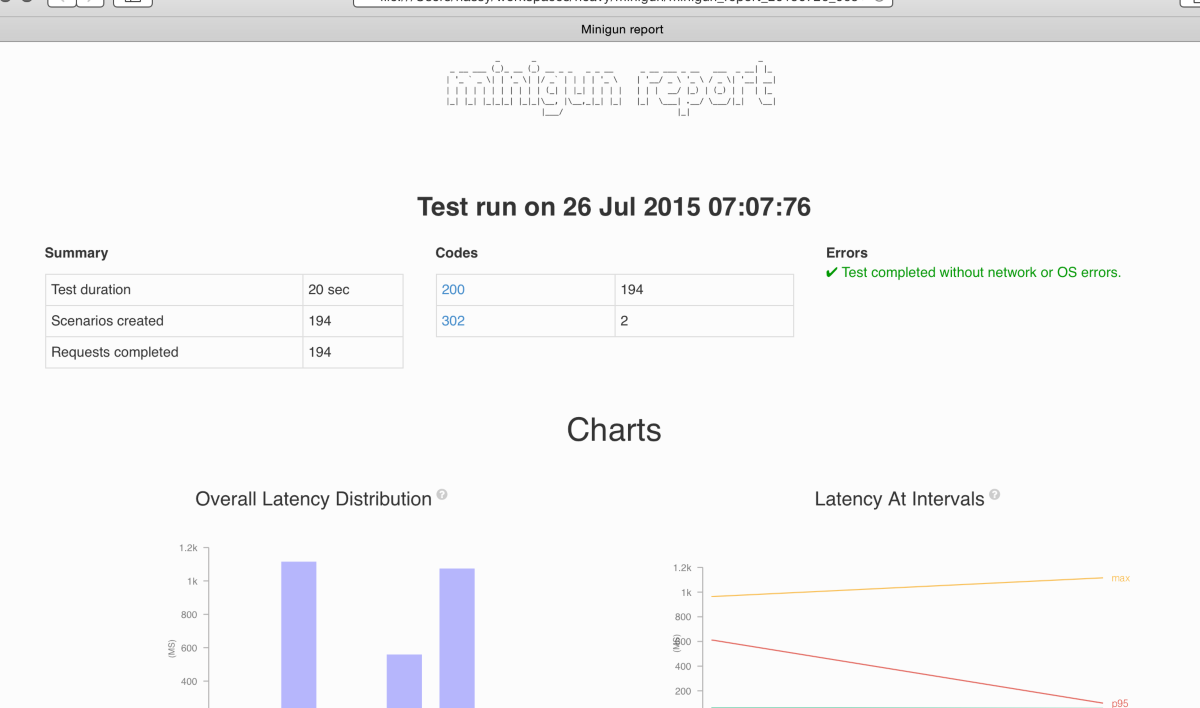_ _
(_) (_)
_ __ ___ _ _ __ _ __ _ _ _ _ __
| '_ ` _ \ | | | '_ \ | | / _` | | | | | | '_ \
| | | | | | | | | | | | | | | (_| | | |_| | | | | |
|_| |_| |_| |_| |_| |_| |_| \__, | \__,_| |_| |_|
__/ |
|___/
minigun is a simple but powerful load-testing tool designed to help you make your apps more performant, reliable, and scalable.
Made by @hveldstra - please @-message me or drop me a line on [email protected] with feedback and suggestions. I love hearing from users.
- HTTP(S) and WebSocket support
- Detailed performance metrics (latency, RPS, throughput)
- NEW! Graphical reports
- Test scenarios are just easy-to-read JSON - all declarative, no code (see an example)
- Use minigun as a standalone CLI tool or as a Node.js library
- Good performance
- Open-source & free
minigun is available via npm
$ npm install -g minigun
$ minigun quick -d 30 -r 5 http://127.0.0.1:3000/test
This will run a test for 30 seconds with an average of 5 new requests to
http://127.0.0.1:3000/test every second.
$ minigun run hello.json
Where hello.json is your tests script that contains something like:
{
"config": {
"target": "http://127.0.0.1:3000",
"phases": [
{ "duration": 120, "arrivalRate": 10 }
],
"defaults": {
"headers": {
"content-type": "application/json",
"x-my-service-auth": "987401838271002188298567"
}
}
},
"scenarios": [
{
"flow": [
{ "get": {"url": "/test"}},
{ "think": 1 },
{ "post": {"url": "/test", "json": { "name": "hassy" }}}
]
}
]
}Create a graphical report from the JSON stats produced by minigun run with:
minigun report <minigun_report_xxxxx.json>
An example: 🎩
- Benchmark the performance of your API or microservice as you're building it
- Ensure new code does not introduce performance regressions
- Test your code for memory leaks
- Benchmark dependencies (libraries, frameworks, external services) to get a feel for their performance characteristics before you integrate
- Run load-tests before you launch to ensure your application can meet projected demand
Send a GET request:
{"get": {"url": "/test"}}POST some JSON:
{"post":
{
"url": "/test",
"json": {"name": "Hassy", "occupation": "software developer"}
}
}POST arbitrary data:
{"post":
{
"url": "/test",
"body": "name=hassy&occuptaion=software%20developer"
}
}You can set headers like this:
{"get":
{
"url": "/test",
"headers": {
"X-My-Header": "123"
}
}
}You can parse responses and reuse those values them in subsequent requests.
In the following example, we POST to /pets to create a new resource, capture part
of the response (the id of the new resource) and store it in the variable id.
We then use that value in the subsequent request to load the resource and to
check to see if the resource we get back looks right.
{"post":
{
"url": "/pets",
"json": {"name": "Mali", "species": "dog"},
"capture": {"json": "$.id", "as": "id"}
}
},
{"get":
{
"url": "/pets/{{ id }}",
"match": {"json": "$.name", "value": "{{ name }}"}
}
}By default, every response body is captured in the variable $, so the
example above could also be rewritten as:
{"post":
{
"url": "/pets",
"json": {"name": "Mali", "species": "dog"}
}
},
{"get":
{
"url": "/pets/{{ $.id }}",
"match": {"json": "$.name", "value": "{{ name }}"}
}
}NOTE: Only JSON is supported at the moment. Support for XML and arbitrary regexps is in the works.
By default, Minigun will reject self-signed certificates. You can disable this behavior (for testing in a staging environment for example):
- Pass --k (or --insecure) option to
minigun runorminigun quick - By setting the
config.tlsproperty in your test script like so:
{
"config": {
"target": "https://myapp.staging:3002",
"tls": {
"rejectUnauthorized": false
}
// ...
},
"scenarios": [
// ...
]
}Set the "engine" field of a scenario to "ws" to enable WS support (the
default engine is "http").
{
"config": {
"target": "ws://echo.websocket.org",
"phases": [
{"duration": 20, "arrivalRate": 10}
]
},
"scenarios": [
{
"engine": "ws",
"flow": [
{"send": "hello"},
{"think": 1},
{"send": "world"}
]
}
]
}NOTE: Support for matching and reusing responses is under development.
Minigun is not a web server benchmarking tool. Its sweet spot is performance testing of applications and APIs with complex transactional scenarios.
Having said that, Minigun is capable of generating 500+ RPS on modest hardware
(a 512MB Digital Ocean droplet). Still though, if you are after raw RPS to
simply hammer a single URL, you may want to use ab instead.
tldr:
Benchmarking an Nginx installation? Use ab. Testing a Node.js
API, a RoR webapp, or a realtime WebSocket-based app? Use Minigun.
minigun test cases are 100% declarative. Your test-case describes what needs to happen, not how it happens.
Benefits of this approach:
- Tests can be 100% reproducible, since there is no custom code.
- Test cases can be auto-generated and analysed by other tools - it's just JSON.
- DSLs can be written for any language. We have a JS DSL on the roadmap, and one can be written easily for Ruby, Python, Lua or another language.
- Stronger performance guarantees can be made in absence of custom code.
Further reading:
minigun uses the Poisson distribution by default to model how requests are spread over the duration of the test.
What does this mean in practice?
If you specify a duration of 60 seconds, with the arrival rate of 10, it means on average 10 users will arrive every second, with for example 8 arrivals one second and 11 arrivals the next. The inter-arrival period would also be slightly different every time, i.e. 5 users arriving within 1 second (1000 ms) would not be evenly spread out 200ms apart.
This may seem like a subtle difference, but in practice it leads to more robust tests.
Thinking of contributing to Minigun? Awesome! Please have a quick look at the guide.
minigun is 100% open-source software distributed under the terms of the ISC license.
Copyright (c) 2015, Hassy Veldstra <[email protected]>
Permission to use, copy, modify, and/or distribute this software for any
purpose with or without fee is hereby granted, provided that the above
copyright notice and this permission notice appear in all copies.
THE SOFTWARE IS PROVIDED "AS IS" AND THE AUTHOR DISCLAIMS ALL WARRANTIES WITH
REGARD TO THIS SOFTWARE INCLUDING ALL IMPLIED WARRANTIES OF MERCHANTABILITY
AND FITNESS. IN NO EVENT SHALL THE AUTHOR BE LIABLE FOR ANY SPECIAL, DIRECT,
INDIRECT, OR CONSEQUENTIAL DAMAGES OR ANY DAMAGES WHATSOEVER RESULTING FROM
LOSS OF USE, DATA OR PROFITS, WHETHER IN AN ACTION OF CONTRACT, NEGLIGENCE OR
OTHER TORTIOUS ACTION, ARISING OUT OF OR IN CONNECTION WITH THE USE OR
PERFORMANCE OF THIS SOFTWARE.
You made it all the way down here, so here's a dinosaur with a minigun:


